Problems with using or understanding language (aphasia) appear, according to statistics from studies conducted by NABI (National Stroke Association), in 25 patients out of 100. Every fourth patient experiences difficulties associated with verbal communication - the ability to speak, write or understand spoken language. and written language. This indicates that acute cerebrovascular accident affected one or more language control centers.
Aphasia is a symptom of brain damage, not a disease. As individual as the picture of damage is, the manifestation of aphasia in each patient is as individual. This condition determines the individual nature of the selection of speech restoration techniques after a stroke for each patient.
There are four main types of post-stroke speech disorders
Damage to the language center in the dominant hemisphere - Broca's area - leads to the fact that patients lose the ability to convey their thoughts using coherent and grammatically correct language structures. Conversely, pathological changes in Wernicke's area (sensory center) lead to problems in receptivity to language. Such patients have difficulty understanding spoken or written language. They often use correct grammatical structures, but their statements may not make sense. The most severe form of aphasia (global or total) occurs in patients with extensive damage to several areas of the brain responsible for understanding and language. The mildest form of aphasia—amnestic—leads to difficulty working with vocabulary.
How do these types of aphasia manifest themselves in practice?
Damage to the language center in the dominant hemisphere - Broca's area - leads to the fact that patients lose the ability to convey their thoughts using coherent and grammatically correct language structures. Conversely, pathological changes in Wernicke's area (sensory center) lead to problems in receptivity to language. These patients have difficulty understanding spoken or written language. They often use correct grammatical structures, but their statements may not make sense. The most severe form of aphasia (global or total) occurs in patients with extensive damage to several areas of the brain responsible for understanding and language. The mildest form of aphasia—amnestic—leads to difficulty working with vocabulary.
How do these types of aphasia manifest themselves in practice?
- Motor aphasia. You know what you want to say, but you can’t find (remember, use and pronounce) the right words.
- Sensory aphasia. You hear someone speak or see printed text, but cannot understand the meaning of the words.
- Amnestic aphasia. You find it difficult to select and use the correct words to refer to certain people, objects, places or events.
- Global aphasia. You cannot speak, write, read and do not understand what is being said to you.
ACOUSTIC-MNESTIC APHASIA
Stage of disorders of moderate and mild severity
1. Expanding the scope of auditory perception:
— display of objects (real and in pictures) by name, presented in pairs, triplets, etc.;
- showing body parts according to the same principle;
— implementation of 2-3-level oral instructions;
— answers to detailed questions, complicated by syntactic structure;
- listening to texts consisting of several sentences and answering questions about the content of the texts;
- writing from dictation with a gradual increase in phrases;
- reading gradually increasing phrases, followed by reproduction (from memory) of each of the sentences and the entire set as a whole.
2. Overcoming weakness of auditory-speech traces:
- repetition from memory of read letters, words, phrases with a gradual increase in the time interval between reading and reproduction, as well as filling the pause with some other type of activity;
— memorizing short poems and prose texts;
— repeated display of objects and pictures after 5-10 seconds, after 1 minute. after the first presentation;
- reading texts with time-delayed retelling (after 10 minutes, 30 minutes, the next day, etc.);
- composing orally sentences using reference words perceived visually;
- listing words by letter with a gradually more complex sound structure, and gradually moving away from the written example of these words.
3. Overcoming naming difficulties:
- analysis of visual images and independent drawing of objects denoted by name words;
- semantic play in contexts of various types of words denoting objects, actions and attributes of objects;
— classification of words with independent finding of a generalizing word;
— exercises on the interpretation of words with concrete, abstract and figurative meaning.
4. Organization of a detailed statement:
- compiling a story based on a series of plot pictures;
- retelling of texts, first according to a detailed plan, then according to a condensed plan, then without a plan;
- extensive dialogues on non-situational topics (professional, social, etc.); practicing samples of communicative and narrative writing (greeting cards, letters, statements, essays on a given topic, etc.).
Stroke: restoration of speech. Exercises
Patients diagnosed with aphasia and speech disorders are concerned with the following questions: is it possible to fully recover from a stroke and how long will it take?
First of all, it is necessary to take into account the irreversibility of the process of destruction of brain cells. To restore the patient’s ability to speak, specialists will need to select means of recovery after a stroke that will help switch speech functions to the closest areas of the brain not affected by the disease. And the timing depends, among other things, on the high inertia of brain cells - after all, it is necessary to switch them to functions unusual for them
Many methods have been developed for restoring speech after a stroke that can speed up this process - speech, melodic, visual, artistic, etc. These speech therapy methods are used along with drug therapy - the patient is prescribed drugs that can stimulate the formation of new neural connections.
The method of intonation (melodic) therapy is based on “singing”. The patient is asked to sing words that cannot be pronounced clearly. Visual therapy uses the ability to form associations between words denoting an object and their visual image.
The most common method of treating aphasia is speech therapy. Classes on the method are conducted with a speech therapist-aphasiologist and are included in the course of intensive rehabilitation of patients after a stroke to the extent necessary for a particular patient.
Exercises to restore speech after a stroke begin with a complex that is designed to gradually restore the patient’s articulatory skills. This could be pronouncing individual sounds, syllables or words, or pronouncing tongue twisters. The exercises are performed with a speech therapist, and the results are consolidated independently in your free time. The more intense the exercise, the greater the likelihood of recovery.
Treatment of aphasia after stroke
Aphasia is a disorder that develops as a result of organic or physical damage to the brain. The cause of this disorder may be injury or stroke.
Diagnosis of speech disorders is carried out by a speech therapist-aphasiologist, a neurologist and a neuropsychologist. The same specialist also conducts the bulk of rehabilitation sessions aimed at returning the patient’s speech skills.
Types of aphasia
Restoring speech after a stroke takes a long time. It is better to start treatment immediately after an attack, otherwise the effectiveness of rehabilitation procedures is significantly reduced. The patient's condition should be monitored by both a speech therapist and a neurologist.
Have questions? Ask them by phone.
A stroke can lead to the development of the following forms of aphasia:
- Sensory. During a stroke, Wernicke's speech center is affected, and as a result of the disorder, the patient loses the ability to understand human speech. The patient pronounces words incorrectly, but does not understand that his speech is impaired.
- Amnestic. The patient can speak coherently, but does not know the names of familiar objects.
- Semantic. The patient is able to understand the meaning of some words, but does not perceive complex sentences.
- Total. A complex lesion that occurs during a major stroke. Patients lose the ability to understand human speech and can only pronounce monosyllabic sounds. With total aphasia, the functioning of the motor and sensory centers of speech is disrupted, which makes the recovery process especially difficult.
It is necessary to begin treatment immediately after determining the form of the speech disorder.
Treatment of aphasia in
Rehabilitation specialists treat aphasia in Yekaterinburg. Before starting treatment, we use comprehensive diagnostics using the following methods:
- testing of oral and written speech;
- MRI and CT of the brain;
- lumbar puncture;
- examination of the vessels of the head and neck.
We conduct classes and other rehabilitation activities both in a rehabilitation center and at the patient’s home. Along with speech therapy exercises, our specialists also use other methods:
- exercise therapy;
- physiotherapeutic procedures;
- training on simulators.
During rehabilitation, our specialists pay special attention to the psychological state of patients. The recovery period is of great importance, and patients experience great stress during this time. Patients often suffer from depression, suicidal thoughts, and also refuse to communicate. That is why during rehabilitation procedures, patients are helped not only by speech therapists, but also by psychologists.
Specialists treat all types of aphasia, so they can restore the ability to speak and express their emotions even to patients in serious condition. If you would like to receive advice regarding the organization of treatment or our methods, we will be happy to provide you with comprehensive information.
Forms of aphasia
Sensory aphasia Its development is based on the loss of phonemic hearing, which leads to the inability to understand the oral speech of others and formulate one’s thoughts. In other words, a person’s native speech sounds incomprehensible to him, and he himself pronounces words in random order, not realizing that his phrases are meaningless. Written speech is also impaired in this case. Only the ability to read is preserved, without comprehending the material read. Sensorimotor aphasia (total aphasia) Both phonemic hearing and speech initiation suffer - the person does not understand the words addressed to him and is not able to start speaking himself. Efferent motor aphasia The patient understands oral and written speech, but speaks and formulates his thoughts with difficulty. A characteristic feature of his speech is the so-called “telegraphic style”, in which a person speaks slowly, unemotionally, with long pauses between words, practically without the use of verbs. Often such patients cannot repeat the phrase said by the doctor, and they can read and write either with difficulty or do not do it at all. Dynamic aphasia (transcortical motor aphasia) The clinical picture is similar to the previous one, but in this case patients are able to repeat phrases after the doctor. Acoustic-comnestic aphasia is characterized by disturbances in expressive speech. The patient distinguishes sounds, but finds it difficult to form words. The main difficulty is recognizing nouns in the stream of speech. The patient replaces them with pronouns. Optical aphasia The patient is unable to name an object shown to him. At the same time, the patient understands why this item is needed. Amnestic aphasia combines the two previous types - acoustic-comnestic and optical-comnestic aphasia. Semantic aphasia is characterized by a violation of the patient's ability to correctly construct sentences. Problems arise both when trying to formulate a complex phrase and when trying to understand the complex statements of the interlocutor.
SEMANTIC APHASIA
Stage of disorders of moderate and mild severity
1. Overcoming spatial apractognosia:
— a schematic representation of the spatial relationships of objects;
- image of the plan of the path, room, etc.;
- design according to a model, according to a verbal task;
— work with a geographical map, hours.
2. Restoring the ability to understand words with spatial meaning (prepositions, adverbs, verbs with “movement” prefixes, etc.):
— a visual representation of simple spatial situations denoted by prepositions and other parts of speech;
— filling in missing “spatial” elements in words and phrases;
- composing phrases with words that have spatial
3. Construction of complex sentences:
— clarification of the meanings of subordinating conjunctions;
— filling in missing main and subordinate clauses;
- composing sentences with given conjunctions.
4. Restoring the ability to understand logical and grammatical situations:
- a picture depiction of the plot of the structure;
- the introduction of additional words that provide semantic redundancy (“my brother’s father”, “a letter from a beloved friend”, etc.);
— introduction of logical-grammatical constructions into a detailed semantic context;
- presenting designs in writing and then orally.
5. Work on an extended statement:
- presentations, essays;
— improvisation on a given topic;
- interpretation of words with complex semantic structure...
Article from the site: wapref.ru/referat_qasyfsujgpolyfsaty.html








